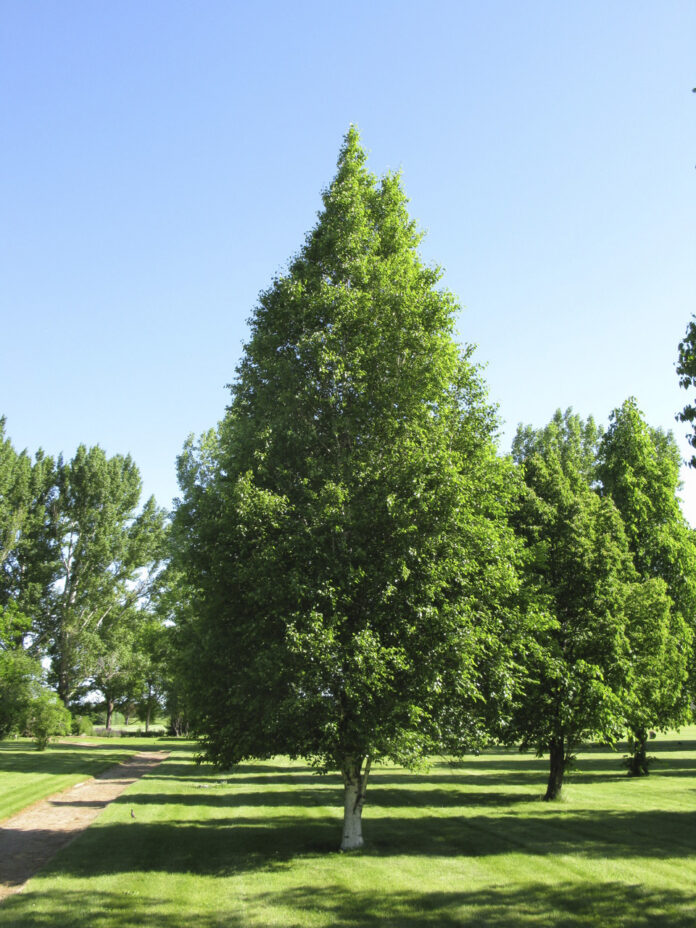
by Sara Williams
Saskatchewan Perennial Society
Manitoba maples, green ash and American elms have dominated prairie landscapes for more than a century. And for much of that time our universities and federal and provincial research stations carried out extensive testing of new trees for hardiness and disease and insect resistance. That task has now fallen to the nursery industry. The Western Nursery Growers Group established four test sites across the prairies in which “new” (and sometimes old) species and varieties were trialed from 2008 to 2016. These were located in Edmonton, Alberta; Strathmore, Alberta; Portage la Prairie, Manitoba; and Saskatoon, Saskatchewan. In each location the trees were rated as recommended (R), marginal (M), or not recommended (NR). For additional information, see the WNGG website: www.prairietrees.ca. Some of the trees recommended for Saskatchewan are described below.
For many years, birches (Betula spp.) were a prominent part of our city landscapes. Drought and the bronze birch borer led to the demise of the vast majority of our birches. Three new introductions are now available. While they will still need even moisture, they have shown resistance (but not immunity) to the ravages of the bronze birch borer. Plant them in full sun to partial shade in well drained average to moist soil. A thick mulch of shredded post peelings is beneficial.
The ‘Chickadee’ paper birch (Betula papyrifera) has a columnar to pyramidal form, is hardy to Zone 2a, and grows to about 40 ft. The foliage turns to gold in fall and its snow white peeling bark provides winter interest. Less susceptible to bronze birch borer.
‘Prairie Dream’ paper birch (Betula papyrifera) is about 40 ft in height with a 25-ft spread. It also has snow white exfoliating bark and golden fall foliage. It is stress tolerant and resistant to the bronze birch borer.
‘Dakota Pinnacle’ birch (Betula platyphylla) is smaller at 25 ft in height with a 10-ft spread and hardy to Zone 3b. It has a dense, narrow pyramidal form well suited for a smaller space, white slightly exfoliating bark, and yellow fall foliage. It is bronze birch borer resistant. Do not allow it to dry out.
The ‘Prairie Horizon’ Manchurian alder (Alnus hirsuta ‘Harbin’) is a largish tree of 40 x 30 ft with a strong central leader, smooth grey bark and dark green glossy leaves that turn yellow in fall. It is hardy to Zone 2 and long lived. Adapted to sun or shade and varying moisture conditions, it is drought-tolerant once established.
Our native larch or tamarack (Larix laricina), found in our boreal forests, is not “new” but seldom planted in our urban landscapes. Yet it is very adaptable to average garden conditions. About 60 x 20 ft at maturity, it does best in full sun in moist soil. It has a narrow pyramidal form. Larch are our only deciduous conifers. The needles are a bright green, turning golden in the fall, and then falling. The small cones appear as tiny wooden rosettes.
‘Oasis’ Siberian larch (Larix sibirica) is slow growing but long lived, about 40 x 20 ft at maturity and hardy to Zone 2a. (Remember, any plant with sibirica in its botanical name is generally hardy on the Canadian prairies!) Fuller and denser than the species, its fine textured foliage remains green into the fall longer than the species before turning golden yellow. It has a low tolerance for urban pollution and is best not planted as a street tree. Plant it in full sun to partial shade in well drained but evenly moist soil.
More to follow!
Sara Williams is the author and coauthor of many books including Creating the Prairie Xeriscape, Gardening Naturally with Hugh Skinner and, with Bob Bors, the recently published Growing Fruit in Northern Gardens. She continues to give workshops on a wide range of gardening topics throughout the prairies.
This column is provided courtesy of the Saskatchewan Perennial Society (SPS; saskperennial@hotmail.com ). Check our website saskperennial.ca) or Facebook page (facebook.com/saskperennial). All Saskatchewan Perennial Society events are on hold until further notice.

